Failure demand always comes at a cost to the business. Whether that’s tangible money-spending or abstract flaws in customer experience. It’s the demand caused by failure to do something right. It’s the demand we do not want, but we dedicate resources to it on a consistent basis. How do you break this cycle?
Recently, we wanted to fix a failure demand issue with our Online Civil Money Claims (OCMC) service. The service is the online portal for starting simple court claims. It's an alternative to the traditional method of issuing a civil claim.
The team had been trying to understand why users often reported confusion about the claim process. The team felt that there was enough guidance on GOV.UK, but based on feedback, many users seemed unaware about what happened after they hit ‘submit claim’. Users were contacting our call centres, only to be given the same information that was already in the GOV.UK guidance.
Understanding our users' perspective
To start, we put ourselves in the place of a user trying to claim the money they’re owed. My first hunch was to go online and use a search engine. I searched for a few terms related to making a money claim to explore the options presented to a user.

We found 2 similar pages on GOV.UK.
The 'Make a court claim for money' was the mainstream guidance. It was for all users looking to submit a claim, both digitally and on paper, and outlined step-by-step actions for the claimant.
The 'Make a money claim online' page turned out to be a separate starting point for the OCMC service. It briefly outlined the pre-application process and referred users back to the mainstream guidance for information on paying the application fee.
Gathering evidence for analysis
The initial request for cross-checking the efficiency of the online guidance started from the service team that had been reviewing call data.
Looking at 6 months of the latest available call data, we found that:
- over half of all incoming claimant calls were requests for 'How to guidance'
- the majority of requests for guidance were at the post-claim and enforcement stage of the process
- Courts and Tribunals Service Centre (CTSC) case administrators spent over a year’s worth of working days answering these 'How-to guidance' calls
Our next step was to review the user behaviour on the guidance pages.
Understanding our users’ behaviour
Where available, we use Google Analytics data to understand users’ behaviour on a website. The platform gives detailed representation on what users do on the webpage, if they’ve opted into cookies. Here’s what we found when reviewing the 2 OCMC pages:
Make a money claim online
This page showed high levels of engagement with the start page, including:
- users spending an average 3 minutes reading the content
- bounce rate within reason
- interaction with clickable elements at almost 80%
Make a court claim for money
At first glance, this page was well-visited, with a reported several hundred thousand of tracked users looking at it within the time period. But when we looked further into its 6 separate sections, we found that visits were primarily driven by pre-claim guidance. Other sections, including guidance on post-claim, hearing and enforcement, were visited by no more than 20% of users.
The connection between the 2 money claims pages was limited. We inferred that only about half of OCMC start page users were referring back to the claim guidance (again, mostly viewing pre-claim guidance). This was already widely coinciding with the call data findings.
Supporting evidence - webforms and feedback
While data is the basis of any research, it’s worth connecting it to the real voice of the user. This is to provide a real story behind the findings.
At the time of analysis, OCMC had a ‘webform’ for user outreach, similar to an email submission. We looked at incoming enquiries, and these confirmed our assumptions. The majority of claimants were asking about the next steps after they submitted a money claim. The comments focussed on “what to do if a defendant does not reply” and “no money has been paid, what are the next steps?”.
We also asked CTSC staff for their feedback, as they seemed best placed to advise on this. Again, topics on no-response and no-payment were on top of the list. In fact, 9 out of 10 of the surveyed case administrators felt that users did not read through the online guidance before contacting the service centre. This strengthened our assumption that the OCMC service users could be missing out on important guidance due to the design of the service start point on GOV.UK.
Analysis outcome
Based on what we found, we built a case for reviewing the OCMC service start point on GOV.UK. We made a request with the Government Digital Service (GDS) to update the 'Make a court claim' page. We removed the separate ‘start page’ and added the OCMC service ‘start now’ button to the mainstream guidance. These changes streamlined the GOV.UK mainstream guidance access for OCMC users across all stages of the journey, meaning users should no longer accidentally miss important guidance.
We'll continue to evaluate and improve our digital services based on user feedback. Find updates on this and other insight and performance projects in future blog posts.
Our team is currently recruiting for a performance analyst role. See the job advert. Reach out to Nicholas Kiddle for more information.

1 comment
Comment by Phillip Beech posted on
Thank you for your post Angelina, extremely helpful and informative...the hidden side of customer experience.
I would be interested to know if/how HMCTS are exploiting insights about "how to Guidance" from their interaction analytics service - please get in touch if it is a topic you'd like to explore.